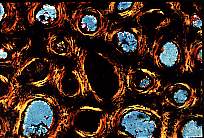Mark Goodwin: Research |
|
|
Mark Goodwin is interested in the preservation of bone. What changes occur when bone is undergoing fossilization, and how does the burial environment affect these changes? Goodwin’s collaborative research has enabled him to draw together ideas from both geochemistry and biology to get a more complete picture of how fossils form. Stable isotopes of oxygen obtained from fossil bone and tooth enamel have been used to reconstruct the paleobiology and life history of extinct organisms. It is presumed that isotopic ratios determined from bone or teeth reflect the ratios in an organism's food source or drinking water, which are dependent on its environment and physiology. Goodwin asserts that when looking at stable isotopes, researchers first need to determine if the molecules they are examining came from the animal in life or the burial environment after death. This distinction is important, because it affects how the data can be used (see "Asking a Key Question" below). |
|
 Asking a Key Question The image above is a thin cross-section of bone from the pachycephalosaur Stegoceras. Some fossilized bone looks just like modern bone under a microscope—the micro-structure of the original bone stays intact through the fossilization process. Goodwin and others are asking the question, “Does the pristine preservation of the microstructure of fossil bone support pristine preservation of the bone’s biogeochemistry?” In other words, fossil bone may look just like modern bone, but is the chemistry the same? Is the mineral structure of the bone original after millions of years? This question has important implications on how fossilized bone can ultimately be used as an indicator of the animal's physiology in life. According to Goodwin, “There are two camps out there right now. One says that you can make a lot of interpretations about life history based on the geochemistry of the bone. The other says you are really measuring the burial environment, not the bone. You are getting indications of what the post-mortem environment is like because diagenesis [physical, chemical, and biological changes that a fossil undergoes after initial burial] has affected the chemical signature. Successful isotopic analysis depends on the preservation of original atoms in the bone.” |
What is your position on this issue? “There are studies that have looked at stable isotope data from dinosaur bone for clues as to whether dinosaurs were warm-blooded [endothermic] or cold-blooded [ectothermic]. We think that dinosaurs were endothermic, or at least certain groups such as theropods. The question is, ‘Which molecules can we analyze confidently to get dietary reconstructions or to explore other behavioral and biological issues?’” With new techniques, Goodwin and his collaborators are developing ways to determine if these molecules are from the original bone or the burial environment. How did you first get involved in this question? “Alaska is particularly interesting because during the Cretaceous period the entire region was enveloped in darkness for 3-6 months a year and temperatures got down to freezing. There were dinosaurs living there year round. How were they successful? Is the chemical composition of fossil bone different from bones in the lower 48 states? This may relate to the way the animals regulated their body temperature in response to the cold climate. The issue is whether the changes seen in fossilized bone reflect an animal’s temperature-regulating strategy or diet, or events that occurred after the bone was buried. “Is the geochemistry [of the Alaskan fossils] different from the Cretaceous bone found in the western interior U.S.? I worked with [UCMP Curator] Bill Clemens to collect specimens in Alaska. Finding this kind of material, I couldn’t help but ask, ‘How was this material preserved?’ And with that, I started looking at the microstructure of the bone. “I’m looking at different questions with the common theme of bone preservation, and one question leads me to another. I’m excited about all of them, and I’m trying to finish them all!”
|
| Browse the Interview: Profile | Interview intro | Path to UCMP | Life in UCMP | |
| Home | What’s new | About UCMP | History of life | Fossil collections | Other resources | |